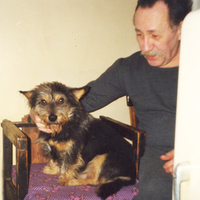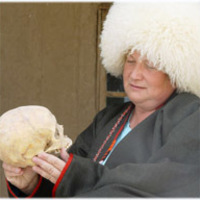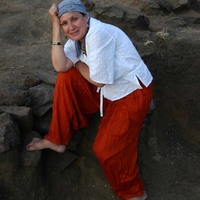
Kozhin Pavel M.
Кожин Павел Михайлович (1934—2016, г. Москва)
АВТОБИОГРАФИЯ
Окончил исторический факультет МГУ — 1959.
Работа по распределению — Институт истории материальной культуры ( Институт Археологии)
09.1959–1.05.1976. До 1968 — лаборант, старший лаборант. Далее младший научный сотрудник.
1963–1966г. — публикация статьи «Кносские колесницы». Поставлен вопрос о состоянии исследований древних текстов, касающихся данной тематики.
12.05.1967 г. — защита в ИА АН СССР кандидатской диссертации «Происхождение фатьяновской культуры».— 414с., илл.
И вынужденное прекращение работ по евразийской проблематике амфорных культур и европейских культур шнуровой керамики
1966–1969 гг. — публикации статей по истории колесного транспорта и наскальным изображениям эпохи бронзы. В том числе «Гобийская квадрига» (Сов. археология, 1968, №3), «К вопросу происхождения иньских колесниц» (Сб. Музея Антропологии и этнографии, 1969, вып. 25)
1974 г. октябрь-ноябрь — закончил первый вариант монографии о колесном транспорте (евразийские находки остатков реальных средств передвижения). — 25 п.л.
1.05.1976 г. — перевод по решению Президиума АН СССР в Институт Дальнего Востока АН СССР.
1982 г. — публикация монографии «Проблемы изучения традиций КНР». — 243с.
1982 г. — депонирование в ИНИОН АН СССР (№ 13481.от 30.06.1983) сокращенного варианта монографии «Проблемы историко-культурных и этнических контактов населения Евразии с IVтыс.до н.э. по первые века н.э.» — 273с.
Осень 1984 г. — завершение монографии «Социально-культурные проблемы религий в Китае» (с дополнением краткого обзора «Религии в КНР»). Более 30 п.л. Не опубликована.
22.10.1990 — защита докторской диссертации «Этнокультурные контакты на территории Евразии в эпохи энеолита — раннего железного века (палеокультурология и колесный транспорт)». Новосибирск, 1990.
1994 — В энциклопедическом словаре «Китайская философия» — 68 статей о ведущих западных синологах и заметка о христианстве в Китае (большинство текстов сокращены при редактировании). Это завершение периода интенсивных занятий религиями Китая.
Октябрь 1994 — переход из Отдела сравнительного изучения философии Востока и Запада в Центр Научной информации и документации на должность ответственного редактора информационных изданий, ведущий научный сотрудник.
1998 — утверждение на должности главного научного сотрудника, XVII разряд.
2007 — издание монографии «Этнокультурные контакты населения Евразии в энеолите–раннем железном веке. Палеокультурология и колесный транспорт. Владивосток. 428с.+43 рис.
2007 — начало работы по подготовке к изданию первого тома 10-томной «Истории Китая». Под общей ред. акад. С.Л. Тихвинского (первый том под ред. акад. А.П. Деревянко, зам. ред.: акад. В.И . Молодин, П.М. Кожин).
2011 — монография «Китай и Центральная Азия до эпохи Чингисхана» 368с.
2012 — биографические размышления на фоне профессии. Или м.б. наоборот размышление над профессией в связи со спецификой биографии (или личности). Любопытно, что при начале опроса я не представлял себе общего смысла этой международной инициативы, лишь ознакомившись с биографиями коллег, понял какую сложную многообразную и нестандартную среду мы представляем. Почему-то легко и изначально формируется вопрос о твоей собственной роли в этой среде. А главное мысль о этой среде как передающем механизме для продолжения и совершенствования востоковедных исследований в Стране. Проблемы эти стали вызывать серьезный интерес, но при их рассмотрении хотелось бы больше серьезности и меньше азарта.
С 2013 г. продолжил разработку тем исторических традиций, ремесленных производств и транспорта в связи с совершенствованием системы государственной власти в Китае, начиная с бронзового века.
АВТОБИОГРАФИЯ
Окончил исторический факультет МГУ — 1959.
Работа по распределению — Институт истории материальной культуры ( Институт Археологии)
09.1959–1.05.1976. До 1968 — лаборант, старший лаборант. Далее младший научный сотрудник.
1963–1966г. — публикация статьи «Кносские колесницы». Поставлен вопрос о состоянии исследований древних текстов, касающихся данной тематики.
12.05.1967 г. — защита в ИА АН СССР кандидатской диссертации «Происхождение фатьяновской культуры».— 414с., илл.
И вынужденное прекращение работ по евразийской проблематике амфорных культур и европейских культур шнуровой керамики
1966–1969 гг. — публикации статей по истории колесного транспорта и наскальным изображениям эпохи бронзы. В том числе «Гобийская квадрига» (Сов. археология, 1968, №3), «К вопросу происхождения иньских колесниц» (Сб. Музея Антропологии и этнографии, 1969, вып. 25)
1974 г. октябрь-ноябрь — закончил первый вариант монографии о колесном транспорте (евразийские находки остатков реальных средств передвижения). — 25 п.л.
1.05.1976 г. — перевод по решению Президиума АН СССР в Институт Дальнего Востока АН СССР.
1982 г. — публикация монографии «Проблемы изучения традиций КНР». — 243с.
1982 г. — депонирование в ИНИОН АН СССР (№ 13481.от 30.06.1983) сокращенного варианта монографии «Проблемы историко-культурных и этнических контактов населения Евразии с IVтыс.до н.э. по первые века н.э.» — 273с.
Осень 1984 г. — завершение монографии «Социально-культурные проблемы религий в Китае» (с дополнением краткого обзора «Религии в КНР»). Более 30 п.л. Не опубликована.
22.10.1990 — защита докторской диссертации «Этнокультурные контакты на территории Евразии в эпохи энеолита — раннего железного века (палеокультурология и колесный транспорт)». Новосибирск, 1990.
1994 — В энциклопедическом словаре «Китайская философия» — 68 статей о ведущих западных синологах и заметка о христианстве в Китае (большинство текстов сокращены при редактировании). Это завершение периода интенсивных занятий религиями Китая.
Октябрь 1994 — переход из Отдела сравнительного изучения философии Востока и Запада в Центр Научной информации и документации на должность ответственного редактора информационных изданий, ведущий научный сотрудник.
1998 — утверждение на должности главного научного сотрудника, XVII разряд.
2007 — издание монографии «Этнокультурные контакты населения Евразии в энеолите–раннем железном веке. Палеокультурология и колесный транспорт. Владивосток. 428с.+43 рис.
2007 — начало работы по подготовке к изданию первого тома 10-томной «Истории Китая». Под общей ред. акад. С.Л. Тихвинского (первый том под ред. акад. А.П. Деревянко, зам. ред.: акад. В.И . Молодин, П.М. Кожин).
2011 — монография «Китай и Центральная Азия до эпохи Чингисхана» 368с.
2012 — биографические размышления на фоне профессии. Или м.б. наоборот размышление над профессией в связи со спецификой биографии (или личности). Любопытно, что при начале опроса я не представлял себе общего смысла этой международной инициативы, лишь ознакомившись с биографиями коллег, понял какую сложную многообразную и нестандартную среду мы представляем. Почему-то легко и изначально формируется вопрос о твоей собственной роли в этой среде. А главное мысль о этой среде как передающем механизме для продолжения и совершенствования востоковедных исследований в Стране. Проблемы эти стали вызывать серьезный интерес, но при их рассмотрении хотелось бы больше серьезности и меньше азарта.
С 2013 г. продолжил разработку тем исторических традиций, ремесленных производств и транспорта в связи с совершенствованием системы государственной власти в Китае, начиная с бронзового века.
less
Related Authors
Nadezhda A Dubova
Institute of Ethnology and Anthropology Russian Academy of Science
Ilia Palaguta
Saint-Petersburg Stieglitz State Academy of Art and Design
Aleksey Nechvaloda
Samara State Academy of Social Sciences and Humanities
Robert Sataev
Institute of Ethnology and Anthropology Russian Academy of Science
Эмма (Emma) Усманова (Usmanova)
Karaganda State University
Grushin Sergey
Altai State University
InterestsView All (58)









Uploads
Books by Kozhin Pavel M.
FULL TEXT IS UNDER SCANNING PROCESS!
NEW PAGES ARE PERIODICALY ADDED! KEEP FOR UPDATES!
This monograph describes a research on the ethno-cultural contacts between ancient social groups throughout Eurasia. In Russian historiography this is the first effort to consider the problem from the perspectives of palaeo-culturology and wheel transportation, with reference to the whole body of Russian and foreign sources.
This work is expected to be of interest to archaeologists, ethnographers, historians, anthropologists and culturologists.
The book contains 43 illustrations, 1 table, and 933 bibliographic references.
Монография посвящена исследованию этнокультурных контактов населения Евразии в древности. Впервые в отечественной историографии данная проблема освещается с точки зрения палеокультурологии и колесного транспорта с привлечением всего корпуса зарубежных и российских источников.
Книга рассчитана на археологов, этнографов, историков, антропологов, культурологов.
Papers: archaeology, history by Kozhin Pavel M.
This text contains fragments of reflections by P.M. Kozhin, recorded by M.A. Glushatova from his words under dictation, over the logic of the historical development of human collectives from primitiveness to the creation of states. A decisive role in this process, according to the author, is played by two factors - the degree of compliance of the natural environment with the vital needs of a given species and the achievement of the level of overpopulation of the territory by the species itself. Several thresholds are noted that led to important turning points in the history of mankind, including the appearance of the first human tools, the creation of clothing and artificial shelters - houses, the ability for collective concerted action, the transition after the stabilization of the post-glacial situation to new conditions and types of activity. The author sees the most perspective beginning of the path of initial states creating as a result of the resettlement of mixed kin communities and communities of place, whose complex and diverse environment was easier to unite under the leadership of an elite that was heterogeneous in origin.
Scythian bowl «fallen from the sky»
The Scythian «logos» by Herodotus has been under expert investigation for over three hundred years. There is no issue that will not arouse both scientific and amateur disputes. The text is a superb literary narrative in which the author assembles plots by combining them from edited quotations by many informants, whose knowledge varies in its level, depth and reliability. The occasional deviation from the autograph due to repeated copying causes unavoidable ambiguities. In the chapter, the theme of the «bowl on the belt» appears twice (IV, 5; 9; 10; 66). First it emerges as a general Scythian property, and then as part of Scythian traditions, where it is linked to yearly regional celebrations, at which Scythians who have distinguished themselves by killing enemies drink wine from a particular crater, drawing it by a special cylix. He who has killed many, drinks from two vessels. The cylix here has the function of a reward in a certain «most ancient state system of rewards» (the theory and practice of similar modern systems, which differ in the signs of rank from those found in medieval orders, subsisting as formations at once religious and secular, is being developed by O. N. Rozanov). Among the diversity of bowls found in the «general Scythian area», we notice the type of ladle made of outer growth on birch bark. Its handle, in the shape of a horse’s leg with a hoof, contains an opening through which it is attached to the belt, and is wrapped in gold foil (Altai, Tuva, Mongolia). The original centre of these customs must have overlapped with the area of military operations of the Achaemenid army of Cyrus II (530 B.C.). (Translated by Marija Milojkovic, University of Belgrade, Serbia)
Кожин П.М., Дубова Н.А. Маргиана в среднеазиатской археологии // Труды Маргианской археологической экспедиции. Том 6. Памяти Виктора Ивановича Сарианиди / Ред. Н.А. Дубова (гл. ред.), Е.В. Антонова, П.М. Кожин, М.Ф. Косарев, Р.Г. Мурадов, Р.М. Сатаев,А.А. Тишкин. – М.: Старый сад, 2016. С. 58–79
THE PECULIARITIES OF TRANSITION TO THE EARLY IRON AGE ON THE
TERRITORY OF NORTH CHINA
The article evaluates different approaches in detection of the beginning of the Early Iron age on the territory of China. The scientific urgency of this kind of review is caused by tendency within the last 10–15 years to suppose the finds of implements made from cast iron much earlier than they were treated before. These artifacts were found at well-examined archaeological sites, such as Shangcunling graveyard of small Zhou princedom Northern Guo (dated from the last quarter of IX to the first quarter of VIII centuries BC) where the examples of meteoritic and metallurgical iron were fixed together in one complex and they both were used as precious objects.
Authors of this article suggest to treat a time of using of new material as definite epoch transi-
tional from bronze to iron; within it some considerable changes in economics as well as in social
structures took place. Data obtained at the moment not only from China, but also from the cultures of neighboring territories give the opportunity for wide-scale dating of this transitional period (called also as «pre-Scythian» or «Early Scythian») within the frame of IX–VII centuries BC. The earlier finds of iron implements from the archaeological sites of Xinjiang (at Yanbulaq, Chawuhu, Yanghai etc.) point out the exact direction for adoption of new material from the regions of Near East and Middle East where iron came into use at least in XIV century BC. Using of iron at the initial stage didn’t give any distinct mechanical advantages over bronze. Developing of iron-cast technology allowed Zhou artisans to arrange mass production of working tools from more available (and, because of it, cheaper) raw material. But the process of hot forging which could produce sharp ends and cutting edges was assimilated only several centuries later. So, up to the beginning of Han Dynasty the most part of weapons’ production we
nt on to use bronze. The swords, dagger-axes, assegais were made from bronzes while the tools (knives, spade-cups, hoes, chisels) – from iron. The correlation between two kinds of metals was fixed also in some narrative sources, f. e. «Guo yu» («The Discourses of the States»), edited at the period of Zhanguo. The armament complex connected with terracotta army of Qin Shihuandi may be used as a striking evidence of this situation, as if the Mausoleum of the First Qin Emperor represents a singular summary on Zhou culture as a whole.
Keywords: early Iron age, meteoritic iron, pig-iron, Shangcunling, Chawuhu, «pre-Scythian» (transitional) period.
FULL TEXT IS UNDER SCANNING PROCESS!
NEW PAGES ARE PERIODICALY ADDED! KEEP FOR UPDATES!
This monograph describes a research on the ethno-cultural contacts between ancient social groups throughout Eurasia. In Russian historiography this is the first effort to consider the problem from the perspectives of palaeo-culturology and wheel transportation, with reference to the whole body of Russian and foreign sources.
This work is expected to be of interest to archaeologists, ethnographers, historians, anthropologists and culturologists.
The book contains 43 illustrations, 1 table, and 933 bibliographic references.
Монография посвящена исследованию этнокультурных контактов населения Евразии в древности. Впервые в отечественной историографии данная проблема освещается с точки зрения палеокультурологии и колесного транспорта с привлечением всего корпуса зарубежных и российских источников.
Книга рассчитана на археологов, этнографов, историков, антропологов, культурологов.
This text contains fragments of reflections by P.M. Kozhin, recorded by M.A. Glushatova from his words under dictation, over the logic of the historical development of human collectives from primitiveness to the creation of states. A decisive role in this process, according to the author, is played by two factors - the degree of compliance of the natural environment with the vital needs of a given species and the achievement of the level of overpopulation of the territory by the species itself. Several thresholds are noted that led to important turning points in the history of mankind, including the appearance of the first human tools, the creation of clothing and artificial shelters - houses, the ability for collective concerted action, the transition after the stabilization of the post-glacial situation to new conditions and types of activity. The author sees the most perspective beginning of the path of initial states creating as a result of the resettlement of mixed kin communities and communities of place, whose complex and diverse environment was easier to unite under the leadership of an elite that was heterogeneous in origin.
Scythian bowl «fallen from the sky»
The Scythian «logos» by Herodotus has been under expert investigation for over three hundred years. There is no issue that will not arouse both scientific and amateur disputes. The text is a superb literary narrative in which the author assembles plots by combining them from edited quotations by many informants, whose knowledge varies in its level, depth and reliability. The occasional deviation from the autograph due to repeated copying causes unavoidable ambiguities. In the chapter, the theme of the «bowl on the belt» appears twice (IV, 5; 9; 10; 66). First it emerges as a general Scythian property, and then as part of Scythian traditions, where it is linked to yearly regional celebrations, at which Scythians who have distinguished themselves by killing enemies drink wine from a particular crater, drawing it by a special cylix. He who has killed many, drinks from two vessels. The cylix here has the function of a reward in a certain «most ancient state system of rewards» (the theory and practice of similar modern systems, which differ in the signs of rank from those found in medieval orders, subsisting as formations at once religious and secular, is being developed by O. N. Rozanov). Among the diversity of bowls found in the «general Scythian area», we notice the type of ladle made of outer growth on birch bark. Its handle, in the shape of a horse’s leg with a hoof, contains an opening through which it is attached to the belt, and is wrapped in gold foil (Altai, Tuva, Mongolia). The original centre of these customs must have overlapped with the area of military operations of the Achaemenid army of Cyrus II (530 B.C.). (Translated by Marija Milojkovic, University of Belgrade, Serbia)
Кожин П.М., Дубова Н.А. Маргиана в среднеазиатской археологии // Труды Маргианской археологической экспедиции. Том 6. Памяти Виктора Ивановича Сарианиди / Ред. Н.А. Дубова (гл. ред.), Е.В. Антонова, П.М. Кожин, М.Ф. Косарев, Р.Г. Мурадов, Р.М. Сатаев,А.А. Тишкин. – М.: Старый сад, 2016. С. 58–79
THE PECULIARITIES OF TRANSITION TO THE EARLY IRON AGE ON THE
TERRITORY OF NORTH CHINA
The article evaluates different approaches in detection of the beginning of the Early Iron age on the territory of China. The scientific urgency of this kind of review is caused by tendency within the last 10–15 years to suppose the finds of implements made from cast iron much earlier than they were treated before. These artifacts were found at well-examined archaeological sites, such as Shangcunling graveyard of small Zhou princedom Northern Guo (dated from the last quarter of IX to the first quarter of VIII centuries BC) where the examples of meteoritic and metallurgical iron were fixed together in one complex and they both were used as precious objects.
Authors of this article suggest to treat a time of using of new material as definite epoch transi-
tional from bronze to iron; within it some considerable changes in economics as well as in social
structures took place. Data obtained at the moment not only from China, but also from the cultures of neighboring territories give the opportunity for wide-scale dating of this transitional period (called also as «pre-Scythian» or «Early Scythian») within the frame of IX–VII centuries BC. The earlier finds of iron implements from the archaeological sites of Xinjiang (at Yanbulaq, Chawuhu, Yanghai etc.) point out the exact direction for adoption of new material from the regions of Near East and Middle East where iron came into use at least in XIV century BC. Using of iron at the initial stage didn’t give any distinct mechanical advantages over bronze. Developing of iron-cast technology allowed Zhou artisans to arrange mass production of working tools from more available (and, because of it, cheaper) raw material. But the process of hot forging which could produce sharp ends and cutting edges was assimilated only several centuries later. So, up to the beginning of Han Dynasty the most part of weapons’ production we
nt on to use bronze. The swords, dagger-axes, assegais were made from bronzes while the tools (knives, spade-cups, hoes, chisels) – from iron. The correlation between two kinds of metals was fixed also in some narrative sources, f. e. «Guo yu» («The Discourses of the States»), edited at the period of Zhanguo. The armament complex connected with terracotta army of Qin Shihuandi may be used as a striking evidence of this situation, as if the Mausoleum of the First Qin Emperor represents a singular summary on Zhou culture as a whole.
Keywords: early Iron age, meteoritic iron, pig-iron, Shangcunling, Chawuhu, «pre-Scythian» (transitional) period.
Опубликовано в: Вестник Новосибирского государственного университета. Серия: История, филология. – 2012. – Т. 12, вып. 10: Востоковедение
Based on archeological data and writing sources, article is a wide panorama of processes and events which accompanied beginning and formation of state in ancient China, in a comparison with similar processes in other regions of the world.
The author makes an attempt to trace the transformation of state system of the ancient China since the epoch of Yin and Zhou by analyzing of the written manuscripts remained through nowadays that describe various spheres of state and public life. Based on various sources, the understanding of the essence of state power and organization of state system is characterized
Дается оценка различных подходов к определению начала раннего железного века на территории Китая. Актуальность такого обзора определяется тем, что в последние 10–15 лет существенно удревнились даты изделий из металлургического железа, найденных в составе хорошо изученных археологических памятников – например, в составе могильника Шанцуньлин (конец IX – начало VIII вв. до н. э.), где совместно найдены предметы из метеоритного и литого железа. Авторы статьи предлагают рассматривать сам момент перехода к новому материалу как определенную эпоху – переходного от бронзы к железу времени, в рамках которой происходят существенные изменения как в области экономики, так и в социальной структуре. Накопленные к настоящему времени материалы (не только по Китаю, но и по культурам сопредельных территорий) позволяют широко датировать этот переходные период (называемый также «предскифским» или «начальным (древне-) скифским») в рамках IX–VII вв. до н. э. Более ранние находки железных изделий на памятниках Синьцзяна указывают на направление заимствования нового материала с территории Ближнего и Среднего Востока, где железа начинает использоваться, по крайней мере, с XIV в. до н. э.
The paper, which is a fragment of an unfinished article, considers, contains assumptions as to the several centres where it took shape and considers its possible prototypes. The problems of the origin of the riding bridle, contains assumptions as to the several centres where it took shape and considers its possible prototypes.
Harnessing of bulls to a plow, harrow or threshing unit was an important prerequisite for the appearance of vehicles. The source area was the Middle East. Due to strengthening of different contacts the types of wheeled vehicles, which had been developed here, spread across the region and beyond its limits where there were new stabilizations – local development of an alien culture, including transport, on the newly developed territory. Migration waves in the late Neolithic – early Copper-Bronze Age rushed to the Balkans (the 1st stabilization). Later they turned to the Caucasus (the 2nd stabilization) and to the North-Pontic steppes (the 3rd stabilization). In Central Asia, where Bactrian camel had been developed, a distinctive type of transport appeared (the 4th stabilization). In Harappa the initial Western-Eurasian type of a wagon is approved (the 5th stabilization).
In the middle of the IInd millennium B.C. the horsedrawn carriage, which attained a high level of technical perfection, appeared in China. Improvement and development of specific functional types of carts, search of animal species fit for transport usage were simultaneously performed. By the beginning of the IInd millennium B.C. different species of bulls and tame species were gradually giving way to a sustainable triad of draft animals: very few breeds of bulls, horses and camels (the latter had a local usage). Language environment of the population, where a horse was spread, was not homogeneous – there were too complex processes of communication, mixtures and confrontations took place in the low-latitude region of Eurasia during this long period.
Key words: Eurasia, cart, chariot, harness, draft animals
ABSTRACT
This paper examines the reform of forces in ancient Chinese northern state Zhao in IV century B.C. conducting heavy struggle against nomads which required use of cavalry. Creation of Chinese cavalry initiated significant technical and sociopolitical innovations, which disturbed popular agricultural traditions.
Данный выпуск Трудов посвящен памяти открывателя нового центра древневосточной цивилизации, основателя и постоянного руководителя Маргианской археологической экспедиции В.И. Сарианиди. Он состоит из трех разделов. В первый из них включены воспоминания друзей и коллег выдающегося археолога; во второй — описание и анализ новых находок и открытий, сделанных на известном памятнике эпохи бронзы Гонур-депе (2300-1600 до н.э.); а в третий — характеристика Гонура и других объектов Бактрийско-Маргианского археологического комплекса (БМАК) в сравнительном контексте с синхронными памятниками Центральной Азии и Ближнего Востока. Затрагиваются вопросы строительства и архитектуры, древней металлургии, мировоззрения населения, глиптики и сфрагистики, биоархеологических реконструкций, реставрации археологических предметов. Значительное место уделяется анализу торговых и культурных связей в пространстве Евразии, значению древней дельты Мургаба как перекрестка путей. Вводится в научный оборот ряд новых уникальных объектов эпохи бронзы, в том числе найденные и на Гонуре.
Данный выпуск Трудов впервые открывает раздел, посвященный памяти двух больших ученых, много сделавших для изучения разных аспектов истории Туркменистана – этнографа В.Н. Басилова и геоморфолога А.А. Ляпина. Основные разделы сборника, как и более ранние, посвящены описанию текущих археологических работ 2011-2012 и частично 2013 гг. на территории дворцово-храмового комплекса конца III – II тыс. до н.э. Гонур Депе (Туркменистан). Здесь присутствуют исследования керамических комплексов, палеоантропологических, археозоологических, палеоботанических материалов, архитектуры памятника, описание работ по музеефикации ряда объектов. Рассматриваются характеристики ландшафта в районе памятника. Описываются особенности золотых изделий и бронзовых сплавов Гонур Депе. Продолжается публикация исследований уникальных мозаик из царских гробниц Гонура. Сборник дополняет статья по одонтологии туркмен юга России.
Сборник посвящен описанию археологических работ 2008-2011 гг. на территории дворцово-храмового комплекса конца III – II тыс. до н.э. Гонур Депе (Туркменистан). В него включены исследования керамических комплексов, палеоантропологического, археозоологического, палеоботанического материалов и петрофонда памятника. В связи с важным открытием, сделанным во время последних сезонов раскопок, - находкой значительного числа специальных погребений собак на царском некрополе, в сборнике публикуются переводы авестийских текстов, посвященных этим животным. Затрагиваются вопросы изучения палеопатологии, реконструкция лица по черепу, описывается случай кефалотафии на Гонуре, а также находка мужского нагрудного украшения сходного с современными туморами. Специальное внимание уделяется подробному изучению уникальных мозаик из царских гробниц Гонура. Сборник дополняют этнолого-исторические исследования, в том числе описание истории узелкового ткачества.
Сборник посвящен описанию археологических работ 2005-2007 гг. на территории дворцово-храмового комплекса конца III – II тыс. до н.э. Гонур Депе (Туркменистан). В него включены исследования керамических комплексов, радиоуглеродных датировок, артефактов, характеризующих развитие палеометаллургии на Гонуре, а также результатам изучения археозоологического, палеоботанического и палеоантропологического материала с этого памятника. Затрагиваются вопросы изучения палеопатологии, методы реконструкции лица по черепу и итоги спектральных исследований металла с синхронных памятников южных районов Средней Азии. Кроме того, предложен метод датирования ранних туркменских ковров.
В сборнике на основании археологических и лингвистических данных обсуждаются проблема прародины индоевропейцев, пути и направления миграций эпохи бронзы, публикуются новейшие результаты изучения архивных материалов, раскопок и антропологических исследований на территории Евразии. Специальное внимание уделяется вопросам охраны и реставрации памятников истории и культуры.